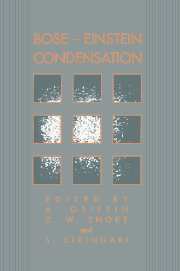Book contents
- Frontmatter
- Contents
- Preface
- Preface to paperback edition
- 1 Introduction: Unifying Themes of Bose–Einstein Condensation
- Part one Review Papers
- 2 Some Comments on Bose–Einstein Condensation
- 3 Bose–Einstein Condensation and Superfluidity
- 4 Bose-Einstein Condensation in Liquid Helium
- 5 Sum Rules and Bose–Einstein Condensation
- 6 Dilute-Degenerate Gases
- 7 Prospects for Bose–Einstein Condensation in Magnetically Trapped Atomic Hydrogen
- 8 Spin-Polarized Hydrogen: Prospects for Bose–Einstein Condensation and Two-Dimensional Superfluidity
- 9 Laser Cooling and Trapping of Neutral Atoms
- 10 Kinetics of Bose–Einstein Condensate Formation in an Interacting Bose Gas
- 11 Condensate Formation in a Bose Gas
- 12 Macroscopic Coherent States of Excitons in Semiconductors
- 13 Bose–Einstein Condensation of a Nearly Ideal Gas: Excitons in Cu2O
- 14 Bose–Einstein Condensation of Excitonic Particles in Semiconductors
- 15 Crossover from BCS Theory to Bose–Einstein Condensation
- 16 Bose–Einstein Condensation of Bipolarons in High-Tc Superconductors
- 17 The Bosonization Method in Nuclear Physics
- 18 Kaon Condensation in Dense Matter
- 19 Broken Gauge Symmetry in a Bose Condensate
- Part two Brief Reports
- Appendix. BEC 93 Participant List
- Index
4 - Bose-Einstein Condensation in Liquid Helium
Published online by Cambridge University Press: 15 December 2009
- Frontmatter
- Contents
- Preface
- Preface to paperback edition
- 1 Introduction: Unifying Themes of Bose–Einstein Condensation
- Part one Review Papers
- 2 Some Comments on Bose–Einstein Condensation
- 3 Bose–Einstein Condensation and Superfluidity
- 4 Bose-Einstein Condensation in Liquid Helium
- 5 Sum Rules and Bose–Einstein Condensation
- 6 Dilute-Degenerate Gases
- 7 Prospects for Bose–Einstein Condensation in Magnetically Trapped Atomic Hydrogen
- 8 Spin-Polarized Hydrogen: Prospects for Bose–Einstein Condensation and Two-Dimensional Superfluidity
- 9 Laser Cooling and Trapping of Neutral Atoms
- 10 Kinetics of Bose–Einstein Condensate Formation in an Interacting Bose Gas
- 11 Condensate Formation in a Bose Gas
- 12 Macroscopic Coherent States of Excitons in Semiconductors
- 13 Bose–Einstein Condensation of a Nearly Ideal Gas: Excitons in Cu2O
- 14 Bose–Einstein Condensation of Excitonic Particles in Semiconductors
- 15 Crossover from BCS Theory to Bose–Einstein Condensation
- 16 Bose–Einstein Condensation of Bipolarons in High-Tc Superconductors
- 17 The Bosonization Method in Nuclear Physics
- 18 Kaon Condensation in Dense Matter
- 19 Broken Gauge Symmetry in a Bose Condensate
- Part two Brief Reports
- Appendix. BEC 93 Participant List
- Index
Summary
Abstract
Liquid helium is the prototypical example of a superfluid – a liquid that flows without viscosity and transfers heat without a temperature gradient. These properties are intimately related to the Bose condensation that occurs in this strongly interacting liquid. Bose condensation is most directly observed in the single particle atomic momentum distribution, where the Bose condensate appears as a delta function singularity. In this article, we discuss the experimental techniques used to observe the condensate and the current status of measurments of the Bose condensate in liquid helium.
Introduction
Liquid helium (4He) has fascinated physicists ever since Kammerlingh-Onnes liquified the last of the so called permanent gases in 1908. However, evidence of what is without doubt the most fascinating property of this unique liquid, superfluidity, was not reported until almost 25 years later [1]. The superfluid phase, where heat is transferred without a thermal gradient and mass flows without a driving pressure, is a macroscopic manifestation of microscopic quantum effects governing the behavior of atoms [2]. Bose–Einstein condensation was first proposed by London [3] as the microscopic explanation for these fascinating phenomena.
Helium is unique among condensed atomic systems since the bulk properties of the liquid are dominated by quantum effects. The most important of these are the statistical effects that arise for identical particles. For bosons, such as 4He atoms, there is no limitation on the number of particles that can occupy a single quantum state.
- Type
- Chapter
- Information
- Bose-Einstein Condensation , pp. 51 - 85Publisher: Cambridge University PressPrint publication year: 1995
- 37
- Cited by



